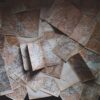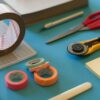Introduction
Coffee tables often sit at the heart of our living rooms, subjected to daily use and the occasional mishap. From water rings left by cold drinks to scratches from the paws of our furry friends, these small blemishes can mar the surface and overall appearance of your beloved table. Fortunately, repairing minor damage to your coffee table is a feasible DIY project that doesn’t require extensive skill or expensive materials. In this blog, we’ll walk you through simple, straightforward techniques to restore your coffee table’s beauty and functionality, ensuring it remains a centerpiece in your home for years to come. Whether it’s a modern minimalist piece or a cherished family heirloom, a little TLC can go a long way in keeping your furniture looking its best.
Assessing the Damage
Image courtesy: Pexels
When it comes to DIY furniture repair, particularly for your beloved coffee table, the first and foremost step is assessing the damage effectively. By closely examining the table, you can identify both the type and extent of the damage, which will guide you in choosing the most suitable repair methods. Proper assessment not only helps in achieving a flawless repair but also in preserving the life and aesthetics of the coffee table.
Identifying Scratches
Scratches on your coffee table can vary drastically in both depth and length, and identifying them correctly is crucial for effective repair. Run your hand gently over the surface to feel for any irregularities. Use a flashlight angled across the surface to visually highlight any scratches that may not be immediately apparent to the naked eye. This method helps in identifying even the finest of scratches that could otherwise be missed.
Determining the Extent of Damage
After identifying the scratches, the next step is to evaluate their depth and the overall extent of the damage. Shallow scratches often only affect the finish of the table, whereas deeper scratches could penetrate into the wood itself. Assess the overall surface area affected; if the damage is localized or widespread will determine the approach and the materials needed for the repair. This assessment is imperative as it dictates the complexity of the repair process and the restoration results you can expect.
DIY Techniques for Repairing Minor Damages
Once you’ve assessed the type and extent of the damage on your coffee table, you can proceed with appropriate DIY repair techniques. These methods are not only cost-effective but can also be a satisfying endeavor, restoring beauty to your furniture with your efforts.
Filling in Scratches with Wood Filler
Wood filler is an excellent choice for dealing with medium to deep scratches. Here’s how you can use it effectively:
– Choose a wood filler that matches the color of your coffee table. If an exact match isn’t available, you can blend different shades to approximate the color.
– Clean the scratch thoroughly to remove any dirt or debris. A clean surface ensures better adhesion of the filler.
– Apply the wood filler into the scratch using a putty knife. Ensure the filler is pushed down into the scratch and smooth over the surface.
– Allow the filler to dry completely, following the manufacturer’s recommended drying time.
– Once dry, gently sand the area with fine-grit sandpaper to achieve a flush finish with the rest of the table’s surface.
This method is most suited for larger, deeper scratches where other methods like touch-up markers might not be as effective.
Sanding and Refinishing the Surface
For scratches that have damaged a larger area or for a coffee table that has multiple scratches, sanding and refinishing the entire surface may be the most appropriate approach. Here’s a step-by-step method:
– Begin by sanding the entire top of the table using a fine-grit sandpaper. Sand in the direction of the wood grain to avoid additional scratches.
– Once the old finish is removed and the surface is smooth, wipe down the table with a clean, damp cloth to remove all sanding dust.
– Apply a new finish matching the original as closely as possible. This could be a wood stain, varnish, or oil. Apply the finish with a brush, again following the grain of the wood.
– Allow the finish to dry thoroughly, applying additional coats as necessary, according to the product instructions.
This method not only repairs scratches but also rejuvenates your entire coffee table, making it look as good as new.
Using Furniture Markers to Conceal Scratches
Furniture touch-up markers are an excellent solution for minor, superficial scratches. They are easy to use and perfect for quickly fixing scratches without much effort. Here’s how you can use them:
– Select a marker that closely matches the color of your coffee table. It’s a good idea to test the marker on an inconspicuous area of the furniture to ensure the color match.
– Clean the scratch thoroughly, ensuring it’s free of any residual dust or dirt.
– Apply the marker to the scratch, gently tracing along the line. Don’t over-apply as it could make the area look blotchy.
– Allow the ink to dry completely. You might need a few applications to completely obscure the scratch.
– Once dry, you can buff the area lightly with a soft cloth.
Furniture markers are best for those who want a quick, no-fuss approach to concealing scratches that do not penetrate deeply into the wood.
Tips for Preventing Future Damages
Image courtesy: Pexels
Coffee tables are central to many living spaces. However, they can experience wear and tear over time. Here are some proven strategies to help keep your coffee table looking its best and prevent future damages.
Using coasters and placemats
An effective way to preserve the surface of your coffee table is by employing coasters and placemats. Here’s why and how this simple practice can make a big difference:
– Avoid Water Rings: Using coasters prevents those dreaded water rings and stains that result from condensation on glasses or mugs.
– Prevent Heat Damage: Similarly, placemats can serve as a barrier against heat damage from hot dishes. The direct contact from hot objects can discolor wood or cause lacquer to bubble or peel.
– Reduce Scratching: After you’ve taken the time to repair any scratches, it only makes sense to guard against new ones. Coasters and placemats cushion the blows from heavy ceramic or metal objects that can otherwise leave a mark.
Implementing this habit can extend the life of your table’s finish and keep it looking pristine for longer. Encourage all household members to use coasters, and perhaps keep extras visible and available to ensure ease of use for guests.
Regular maintenance and cleaning
Regular maintenance is crucial for keeping your coffee table in top condition. Here are some valuable tips on how to maintain and clean your coffee table efficiently:
– Dust Often: Dust and other particles can accumulate quickly, especially in a living room. Regular dusting prevents these particles from scratching the table’s surface when they are rubbed across the wood. Use a soft, clean microfiber cloth to wipe the surface gently.
– Clean Spills Immediately: Any spills should be cleaned up right away to avoid stains. Use a slightly damp cloth and wipe dry with a clean towel to ensure no moisture remains on the wood.
– Polish Periodically: Depending on the type of finish of your coffee table, polishing can also be beneficial. For wood tables, consider using a wood polish every few months to keep the finish bright and prevent the wood from drying out. Always test the polish on a small, inconspicuous area first.
– Avoid Harsh Chemicals: It’s tempting to use all-purpose cleaners for convenience, but these can be too harsh for delicate furniture surfaces. Instead, opt for cleaners specifically designed for furniture or even mild soapy water. Rinse the cloth well to ensure no soap residue is left behind.
By incorporating these straightforward maintenance routines into your regular cleaning schedule, you’ll not only preserve the appearance of your coffee table but also extend its lifespan. Remember, taking a little time for upkeep can save a lot of time on repairs down the road.
Conclusion
As you can see, repairing minor damages on your coffee table doesn’t require professional help and can be quite satisfying to do on your own. With a few basic supplies and a little bit of patience, you can breathe new life into your furniture. Remember, the key is to take your time and pay attention to detail to achieve the best results. Now, you’re all set to enjoy your rejuvenated coffee table while basking in the glow of a job well done!









